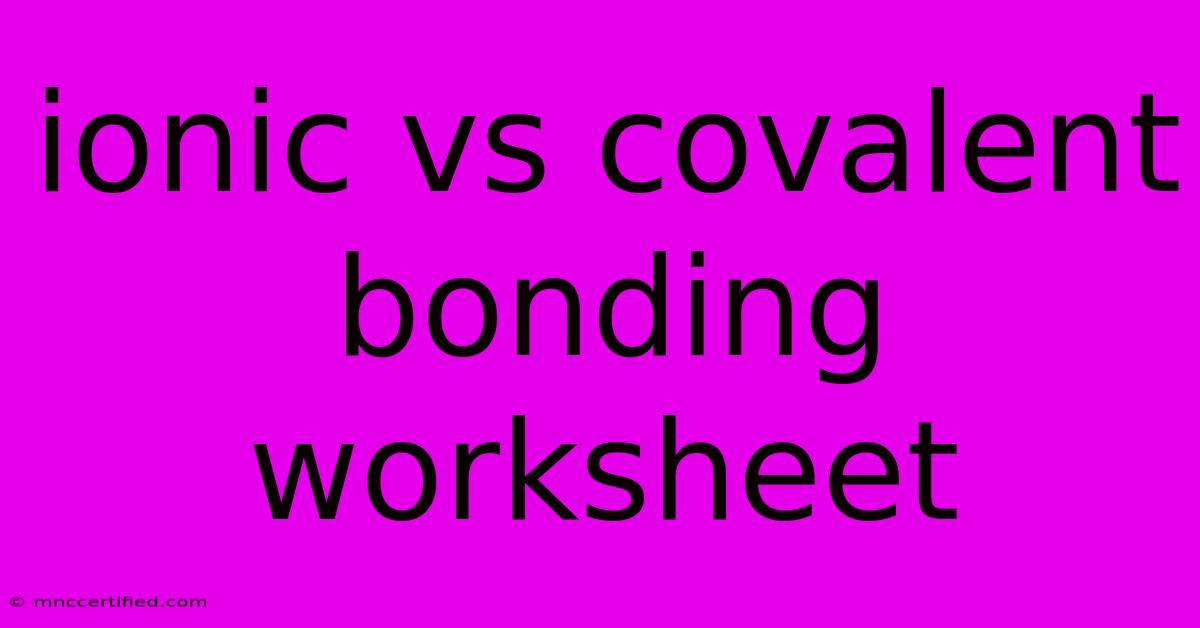Ionic Vs Covalent Bonding Worksheet

Table of Contents
Ionic vs. Covalent Bonding Worksheet: Mastering the Fundamentals of Chemical Bonding
Understanding the fundamental principles of chemical bonding is crucial for any student of chemistry. This worksheet delves into the differences between ionic and covalent bonding, helping you strengthen your grasp of these concepts and learn how to identify them in various chemical compounds.
What is Chemical Bonding?
Chemical bonding is the process of atoms forming stable units called molecules. This occurs when atoms share or transfer electrons to achieve a more stable electron configuration. There are several types of chemical bonds, but we will focus on two main categories: ionic bonding and covalent bonding.
Ionic Bonding: The Dance of Opposites
Ionic bonding involves the transfer of electrons from one atom to another. This transfer creates ions: atoms with a positive or negative charge.
- Metal atoms tend to lose electrons, forming cations (positive ions).
- Nonmetal atoms tend to gain electrons, forming anions (negative ions).
The opposite charges of these ions attract each other strongly, forming a strong electrostatic attraction that holds the ions together in a crystal lattice. This attraction is what defines an ionic bond.
Key Characteristics of Ionic Bonding:
- Occurs between metals and nonmetals.
- Involves electron transfer leading to the formation of ions.
- Results in strong electrostatic attraction between oppositely charged ions.
- Forms crystal lattices with high melting and boiling points.
- Often dissolves in water, forming electrolytes.
Covalent Bonding: Sharing is Caring
Covalent bonding involves the sharing of electrons between two atoms. This sharing allows both atoms to achieve a more stable electron configuration.
Key Characteristics of Covalent Bonding:
- Occurs between nonmetals.
- Involves sharing of electrons to achieve a stable electron configuration.
- Forms molecules with various shapes and sizes.
- Can be polar or nonpolar depending on the electronegativity difference between the atoms.
- Has lower melting and boiling points compared to ionic compounds.
Worksheet: Identifying Ionic and Covalent Bonds
Now, let's put your knowledge to the test. For each of the following compounds, identify the type of bonding present and explain your reasoning.
- NaCl (Sodium Chloride)
- H₂O (Water)
- CO₂ (Carbon Dioxide)
- MgO (Magnesium Oxide)
- CH₄ (Methane)
Answer Key:
- Ionic: Sodium (Na) is a metal, and Chlorine (Cl) is a nonmetal. Sodium loses an electron to form a positive ion (Na+), while Chlorine gains an electron to form a negative ion (Cl-). These oppositely charged ions attract each other to form an ionic bond.
- Covalent: Both Hydrogen (H) and Oxygen (O) are nonmetals. They share electrons to achieve a stable electron configuration, forming covalent bonds within the water molecule.
- Covalent: Carbon (C) and Oxygen (O) are both nonmetals. They share electrons to form covalent bonds within the carbon dioxide molecule.
- Ionic: Magnesium (Mg) is a metal, and Oxygen (O) is a nonmetal. Magnesium loses two electrons to form a positive ion (Mg2+), while Oxygen gains two electrons to form a negative ion (O2-). These oppositely charged ions attract each other to form an ionic bond.
- Covalent: Carbon (C) and Hydrogen (H) are both nonmetals. They share electrons to form covalent bonds within the methane molecule.
Mastering the Basics
By working through this worksheet, you've taken a significant step towards understanding the fundamental principles of ionic and covalent bonding. This knowledge serves as a strong foundation for further exploration of chemical bonding and other important chemical concepts.
Remember: Practice makes perfect! Continue to apply your knowledge to different examples, and don't hesitate to seek help from your teacher or classmates if needed.

Thank you for visiting our website wich cover about Ionic Vs Covalent Bonding Worksheet. We hope the information provided has been useful to you. Feel free to contact us if you have any questions or need further assistance. See you next time and dont miss to bookmark.
Featured Posts
-
Megan Fox Pregnant Expecting Baby With Mgk
Nov 12, 2024
-
Chances Of Getting A Bond Reduction
Nov 12, 2024
-
Jumped The Shark Fans Slam Yellowstones Costner Sendoff
Nov 12, 2024
-
Tom Homan Back As Ice Chief
Nov 12, 2024
-
Megan Fox And Mgk Welcome First Baby
Nov 12, 2024